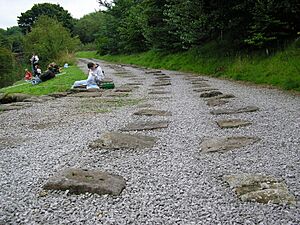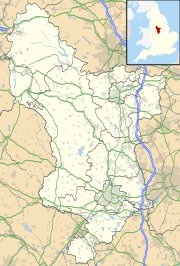Peak Forest Tramway facts for kids
The Peak Forest Tramway was an old railway system in Derbyshire, England. It used horses and gravity to move goods. It opened on August 31, 1796, and was used until the 1920s. Many parts of the tramway and its buildings are still there today. The western part of the line is now a walking and cycling path called the Peak Forest Tramway Trail.
The tramway was first planned to be about 4 miles (6.4 km) long. It would run from Chapel Milton to Dove Holes. But it was decided to start the tramway at Bugsworth (now called Buxworth). So, it ended up being about 6 miles (9.7 km) long. Its main job was to carry limestone from big quarries near Dove Holes. The limestone went down to Bugsworth Basin. From there, much of it traveled by boat along the Peak Forest Canal and the Ashton Canal to Manchester and other places. Some limestone was also turned into quick lime at Bugsworth.
Contents
Building the Tramway: How It Was Made
The tramway was built by Benjamin Outram. At first, it had only one track. The tracks were 4 feet 2 inches (1.27 meters) wide. They were made of L-shaped cast-iron rails. These rails were fixed directly onto stone blocks, which acted like modern railway sleepers. The company that made the rails also supplied the wagons.
The tramway started at Bugsworth and went uphill about 129 feet (39 meters) to Whitehough. Then it was flat to Chapel Milton. After that, it climbed a steep section called an inclined plane. This section went up 192 feet (58.5 meters) over a distance of 512 yards (468 meters). After a gentler slope, the line reached the Dove Holes quarries.
How the Inclined Plane Worked
The steep inclined plane helped move wagons up and down. It was designed to be partly "self-acting." This meant that wagons going down helped pull wagons going up. The slope changed from very steep at the top (1 in 6) to less steep at the bottom (1 in 12). This helped wagons start moving at the top and slow down at the bottom.
At first, ropes were used, then a special twisted chain. This chain went around a wheel with a brake at the top. Later, a strong chain with 5-inch (12.7 cm) links was bought from Birmingham. This chain worked much better. By the early 1900s, a strong steel rope was used instead. There was also a smaller incline inside the quarry. A horse-powered machine helped move wagons there.
The Wagons
The wagons used on the tramway were made to carry limestone. They had a strong wooden base and a wrought-iron body. The wheels were made of cast iron and were about 20 inches (50 cm) wide. Each wagon could carry between 2 and 2.5 tons of limestone.
Later, the wagons had a door at the back. They could be unloaded using a special tipping machine on a turntable. From the bottom of the inclined plane to Bugsworth Basin, a team of four horses could pull up to twenty wagons. Workers would ride on the wagon axles. They used wooden sticks to slow the wheels and keep the speed between 4 to 6 miles per hour (6.4 to 9.7 km/h).
History of the Tramway
In 1803, the tramway was made into a double-track line. This meant it had two tracks instead of one. However, some parts, like Stodhart Tunnel, stayed single-track.
Over time, the rails sometimes became loose. So, between 1832 and 1837, the main line was rebuilt. New supports were placed between the rails and the stone blocks. The design of the rails changed many times over the years. Around 1865, much of the main line was replaced with L-shaped steel rails. These new rails were 9 to 12 feet (2.7 to 3.7 meters) long.
In 1846, a railway company called the Sheffield, Ashton-under-Lyne and Manchester Railway took over the Peak Forest Canal and the tramway. They paid £9,325 a year to use it. This company later became the owner of the canal and tramway in 1883. The tramway stopped working in 1920. Its rails and wagons were then sold by the LNER.
What Remains Today
Many important parts of the tramway can still be seen today. These include the raised tramway branch at Bugsworth Basin. Also, Stodhart Tunnel and the self-acting inclined plane at Chapel-en-le-Frith are still there. The elevated tramway branch is part of a protected historical site at Bugsworth Basin.
For a long time, Stodhart Tunnel was thought to be the oldest railway tunnel in the world. It is a Grade II* listed site, meaning it's very important. But in 2013, some research showed that Fritchley Tunnel on another old line in Derbyshire might be even older. You can see one of the original wagons from the Peak Forest Tramway at the York Railway Museum. Also, a wheel and some track parts are on display at the Narrow Gauge Railway Museum.
Images for kids





